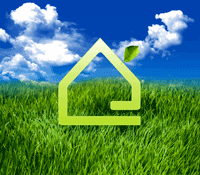4. Replace your furnace. If your home has an old furnace, you are throwing money away every winter. Tackle this green home improvement project over a weekend or have a professional install a new unit for you. Newer furnaces operate at about 97% efficiency and use much less fuel so youíll be saving even more money. With the rising cost of home heating oil and propane, this can be very significant. If you have electric heat, you can still save a bundle on your electric bill every month.
Green homes are a new trend in sustainable living and construction. These homes are designed and built to be environmentally friendly, energy efficient, and healthy for their occupants. The main goal of green homes is to minimize their carbon footprint and reduce the negative impact of construction and living on the environment.
Green homes are designed with a focus on sustainable materials, energy efficiency, and healthy indoor air quality. These homes often incorporate elements like solar panels, energy-efficient windows, and insulation, to minimize energy consumption and reduce heating and cooling costs. They also incorporate environmentally friendly building materials like bamboo flooring, recycled glass tiles, and low-VOC paints, to reduce indoor air pollution and minimize harm to the environment.
One of the key elements of green homes is their use of renewable energy sources. Solar panels, for example, can provide clean and renewable energy for a home, reducing its dependence on fossil fuels and reducing its carbon footprint. Wind turbines are another popular option for green homes, as they can generate electricity without emitting harmful pollutants into the atmosphere.
Green homes also incorporate water-saving technologies, such as low-flow toilets and showerheads, to reduce water waste and conserve this precious resource. They may also use rainwater harvesting systems, which collect and store rainwater for use in landscaping, irrigation, and even household tasks like washing clothes and flushing toilets.
Another important aspect of green homes is their focus on indoor air quality. These homes are designed to minimize the use of toxic chemicals, such as formaldehyde, in building materials and finishes. They also incorporate features like improved ventilation systems, which bring fresh air into the home, reducing the levels of indoor air pollution and improving the health of its occupants.
In addition to being environmentally friendly, green homes are also designed to be healthy for their occupants. They often incorporate natural light, which has been shown to improve mood and cognitive function, and features like indoor gardens and green roofs, which provide a connection to nature and can help reduce stress levels. Green homes also prioritize comfort and livability, with features like passive solar heating and cooling, which use the sun’s energy to regulate the temperature inside the home, and improved insulation, which reduces drafts and helps to maintain a comfortable indoor environment.
The construction of green homes often involves a collaborative process between the homeowner, architect, and contractor. This collaboration is important for ensuring that the home is designed and built to meet the homeowner’s specific needs and preferences, while also meeting environmental standards. A green home may also be certified through a third-party organization, such as LEED or the National Green Building Standard, which provides a framework for evaluating the environmental impact of a building and ensuring that it meets certain sustainability criteria.
The benefits of green homes go beyond the environmental and health benefits for the homeowner. They can also result in significant financial savings over time. Energy-efficient homes use less energy, which means lower energy bills, and they also tend to have a longer lifespan, as they are built with sustainable materials and are designed to last. Green homes can also increase in value over time, as they become more popular and desirable, and may be more attractive to potential buyers who are looking for an environmentally friendly and sustainable living space.
In conclusion, green homes are a new trend in sustainable living and construction. They are designed to be environmentally friendly, energy efficient, and healthy for their occupants, with a focus on renewable energy, water conservation, indoor air quality, and natural light. The construction of green homes often involves a collaborative process between the homeowner, architect, and contractor, and can result in significant financial savings and increased property value over time. Green homes are an investment in the future of our planet, and a way for homeowners





